Mil Mi-26
| Mi-26 | |
|---|---|
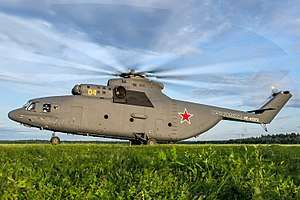 | |
| Russian Air Force Mi-26 | |
| Role | Heavy lift cargo helicopter |
| National origin | Soviet Union/Russia |
| Manufacturer | Rostvertol |
| Design group | Mil Moscow Helicopter Plant |
| First flight | 14 December 1977 |
| Introduction | 1983 |
| Status | In service |
| Primary users | Russian Air Force Aeroflot Ukrainian Air Force Indian Air Force |
| Produced | 1980–present |
| Number built | 316 as of 2015[1] |
| Unit cost | |
The Mil Mi-26 (Russian: Миль Ми-26, NATO reporting name: Halo) is a Soviet/Russian heavy transport helicopter. Its product code is izdeliye 90. Operated by both military and civilian operators, it is the largest and most powerful helicopter to have gone into series production.
Design and development
Following the incomplete development of the heavier Mil Mi-12 (prototypes known as Mil V-12) in the early 1970s, work began on a new heavy-lift helicopter, designated as the Izdeliye 90 ("Project 90")[4] and later allocated designation Mi-26. The new design was required to have an empty weight less than half its maximum takeoff weight.[5] The helicopter was designed by Marat Tishchenko, protégé of Mikhail Mil, founder of the OKB-329 design bureau.[6]
The Mi-26 was designed to replace earlier Mi-6 and Mi-12 heavy lift helicopters and act as a heavy-lift helicopter for military and civil use, having twice the cabin space and payload of the Mi-6, then the world's largest and fastest production helicopter. The primary purpose of the Mi-26 was to transport military equipment such as 13 metric ton (29,000 lb) amphibious armored personnel carriers and mobile ballistic missiles to remote locations after delivery by military transport aircraft such as the Antonov An-22 or Ilyushin Il-76.
The first Mi-26 flew on 14 December 1977[7] and the first production aircraft was rolled out on 4 October 1980.[4] Development was completed in 1983 and by 1985, the Mi-26 was in Soviet military and commercial service.[5]
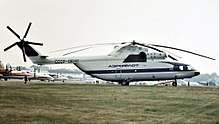
The Mi-26 was the first factory-equipped helicopter with a single, eight-blade main lift rotor. It is capable of flight in the event of power loss by one engine (depending on aircraft mission weight) thanks to an engine load sharing system. While its empty weight is only slightly higher than the Mi-6's, the Mi-26 has a payload of up to 20 metric tons (44,000 lb). It is the second largest and heaviest helicopter ever constructed, after the experimental Mil V-12. The tail rotor has about the same diameter and thrust as the four-bladed main rotor fitted to the MD Helicopters MD 500.[8]
The Mi-26's unique main gearbox is relatively light at 3,639 kg (8,023 lb)[9] but can absorb 19,725 shaft horsepower (14,709 kW), which was accomplished using a non-planetary, split-torque design with quill shafts for torque equalization.[10] The Mil Design Bureau designed the VR-26 transmission itself, due to the normal gearbox supplier used by Mil admitting that it could not design such a gearbox.[11] The gearbox housing is stamped aluminum.[9] A split-torque design is also used for the 12,500 lb (5,670 kg) gearbox on the American three-engine Sikorsky CH-53K King Stallion.[12]
As of 2016, the Mi-26 still holds the Fédération Aéronautique Internationale world record for the greatest mass lifted to 2,000 metres (6,562 ft) – 56,768.8 kilograms (125,153.8 lb) on a flight in 1982.[13]
In July 2010 a proposed Russian-Chinese development of a 33-ton heavy-lift helicopter was announced.[14]
Rostvertol, the Russian helicopter manufacturer, was contracted to refurbish and upgrade the entire fleet of Mi-26s serving in the Russian Air Force, estimated to be around 20 helicopters. The upgraded aircraft is comparable to a new variant, the Mi-26T. Contract completion was planned for 2015. The contract also covered the production of 22 new Mi-26T helicopters. Eight new-built helicopters were delivered to operational units by January 2012.[15] Under the 2010 contract, 17 new-production helicopters were delivered by 2014.[16] In all, Rostvertol delivered fourteen Mi-26s to domestic and foreign customers in the period 2012–14 and six helicopters in 2015.[17] Deliveries to the Russian Air Force were continued in 2016 and 2017.[18][19][20]
In 2016, Russia started development of PD-12V a variant of the Aviadvigatel PD-14 turbofan engine to power the Mi-26.[21]
Operational history
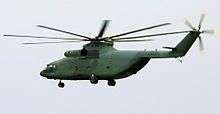
Buran programme
The developers of the Buran space vehicle programme considered using Mi-26 helicopters to "bundle" lift components for the Buran spacecraft, but test flights with a mock-up showed this to be risky and impractical.[22]
Chernobyl accident
The Mi-26S was a disaster response version hastily developed during the containment efforts of the Chernobyl nuclear accident in 1986.[23] Thirty Mi-26 were used for radiation measurements and precision drops of insulating material to cover the damaged No. 4 reactor. It was also equipped with a deactivating liquid tank and underbelly spraying apparatus. The Mi-26S was operated in immediate proximity to the nuclear reactor, with a filter system and protective screens mounted in the cabin to protect the crew during delivery of construction materials to the most highly contaminated areas.[24]
Siberian Woolly Mammoth recovery
In October 1999, an Mi-26 was used to transport a 25-ton block of frozen soil encasing a preserved, 23,000-year-old Woolly Mammoth (Jarkov Mammoth) from the Siberian tundra to a lab in Khatanga, Taymyr. Due to the weight of the load, the Mi-26 had to be returned to the factory afterward to check for airframe and rotor warping caused by the potential of structural over-stressing.[6]
Afghanistan Chinook recovery
In the spring of 2002, a civilian Mi-26 was leased to recover two U.S. Army MH-47E Chinook helicopters from a mountain in Afghanistan. The Chinooks, operated by the 160th Special Operations Aviation Regiment, had been employed in Operation Anaconda, an effort to drive al Qaeda and Taliban fighters out of the Shahi-Kot Valley and surrounding mountains. They found themselves stranded on the slopes above Sirkhankel at altitudes of 2,600 metres (8,500 ft) and 3,100 metres (10,200 ft). While the second craft was too badly damaged to recover, the first was determined to be repairable and estimated to weigh 12,000 kilograms (26,000 lb) with fuel, rotors, and non-essential equipment removed. That weight exceeded the maximum payload of 9,100 kilograms (20,100 lb) at an altitude of 2,600 metres (8,500 ft) of the U.S. military's Sikorsky CH-53E.[6]
The Mi-26 was located through Skylink Aviation in Toronto, which had connections with a Russian company called Sportsflite that operated three civilian Mi-26 versions called "Heavycopters". One of the aircraft, aiding in construction and firefighting work in neighboring Tajikistan, was leased for $300,000; it lifted the Chinook, flew it to Kabul, then later to Bagram Air Base, Afghanistan to ship to Fort Campbell, Kentucky, U.S. for repairs. Six months later, a second U.S. Army CH-47 that had made a hard landing 100 miles (160 km) north of Bagram at an altitude of 1,200 metres (3,900 ft) was recovered by another Sportsflite-operated Mi-26 Heavycopter.[6]
Chechnya crash
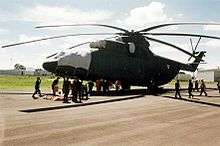
On 19 August 2002, Chechen separatists hit an overloaded Mi-26 with a surface-to-air missile, causing it to crash-land in a minefield, killing 127 of the people on board.[25]
China, Wenchuan "quake lake" emergency
As a result of the magnitude 8.0 earthquake in Sichuan province of China on 12 May 2008, many rivers became blocked by landslides, resulting in the formation of so-called quake lakes: large amounts of water pooling up behind the landslide-formed dams. These dams eventually broke under the weight of the water,[26] endangering those downstream. At least one Mi-26 belonging to a branch of China's civil aviation service was used to bring heavy earth moving tractors to the quake-lakes at Tangjiashan mountain, located in difficult terrain and accessible only by foot or air.[27]
Afghanistan helicopter downing
In July 2009, a Moldovan Mi-26 was shot down in Helmand province with the loss of six Ukrainian crew members. The aircraft, belonging to Pecotox Air, was said to be on a humanitarian mission under NATO contract.[28]
Indian Air Force Mi-26 crash
On 14 December 2010, an Indian Air Force Mi-26 crashed seconds after taking off from Jammu Airport, injuring all nine passengers. The aircraft fell from an altitude of about 50 feet (15 m).[29] The Indian Institute of Flight Safety released an investigation report that stated improper fastening of the truck inside caused an imbalance of the helicopter and led to the crash. The Mi-26 had been carrying machines from Konkan Railway to Jammu–Baramulla line project.[30][31]
Norwegian Air Force Sea King recovery
On 11 December 2012, a Westland Sea King from No. 330 Squadron RNoAF experienced undisclosed technical issues and made an emergency landing on Mount Divgagáisá. The landing caused parts of the landing gear to break. The Sea King was prepared by removing rotor blades and fuel before it was airlifted to Banak Air Station by a Russian Mil Mi-26 on 23 December 2012.[32]
Variants
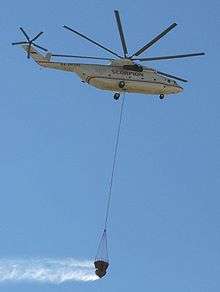
- V-29
- Prototype version
- Mi-26
- Military cargo/freight transport version.[33] NATO name: 'Halo-A'.
- Mi-26A
- Upgraded military version with a new flight/navigation system. Flown in 1985 but no production.[33]
- Mi-26M
- Upgraded version of the Mi-26 for better performance.
- Mi-26S
- Disaster response version developed in response to nuclear accident at Chernobyl.[33]
- Mi-26T
- Basic civil cargo/freight transport version. Production from 1985.[33]
- Mi-26TS
- Civil cargo transport version, also marketed as Mi-26TC.[33]
- Mi-26TM
- Flying crane version with under-nose gondola for pilot/crane operator.[33]
- Mi-26TP
- Firefighting version with internal 15,000 litres (4,000 US gal; 3,300 imp gal) fire retardant tank.[33]
- Mi-26MS
- Medical evacuation version of Mi-26T. Up to 60 stretcher cases in field ambulance role, or can be equipped for intensive care or as field hospital.[33]
- Mi-26P
- 63 seat passenger version.[33]
- Mi-26PK
- Flying crane derivative of Mi-26P.[33]
- Mi-26T2
- Improved version of the Mi-26T equipped with BREO-26 airborne electronic system, allowing it to fly any time, day or night, under good and bad weather conditions. Serial production began on May 22, 2015.[34]
- Mi-26T2V
- Upgrade outfitted with new armor and equipment that has already been tested during military operations in Syria.[35]
- Mi-27
- Proposed airborne command post variant; two prototypes built.
Operators
Military operators
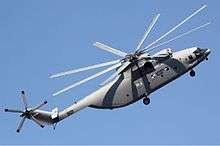
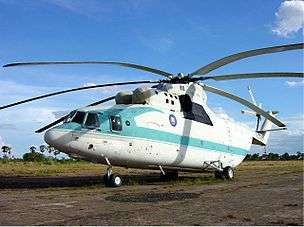
_RP10149.jpg)
Civil operators
.jpg)
Former operators
Specifications (Mi-26)
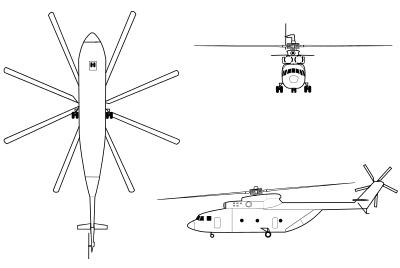
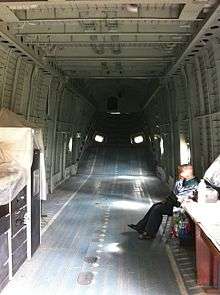
Data from Jane's All the World's Aircraft 2003–2004[33]
General characteristics
- Crew: Five: 2 pilots, 1 navigator, 1 flight engineer, 1 flight technician
- Capacity:
- 90 troops or 60 stretchers
- 20,000 kg cargo (44,090 lb)
- Length: 40.025 m (131 ft 3¾ in) (rotors turning)
- Rotor diameter: 32.00 m (105 ft 0 in)
- Height: 8.145 m (26 ft 8¾ in)
- Disc area: 804.25 m2 (8,656.8 ft²)
- Empty weight: 28,200 kg (62,170 lb)
- Loaded weight: 49,600 kg (109,350 lb)
- Max. takeoff weight: 56,000 kg (123,450 lb)
- Main rotor speed: 132 RPM
- Powerplant: 2 × Lotarev D-136 AI-136 (or PD-12V altpw) turboshafts, 8,500 kW (10–11,398 shp or ~ 10–12,000 of PD12V) each
Performance
- Maximum speed: 295 km/h (159 kn, 183 mph)
- Cruise speed: 255 km/h (137 kn, 158 mph)
- Range: 800 km (430 nmi; 500 mi) ()
- Ferry range: 1,920 km (1,036 nmi, 1,190 mi) (with auxiliary tanks)
- Service ceiling: 4,600 m (15,100 ft)
See also
Aircraft of comparable role, configuration and era
References
- Citations
- ↑ Number of Mi-26 built
- ↑ Объём экспортных продаж новых тяжёлых транспортных вертолётов в 2012—2015 гг. составит около 5,6 млрд долларов
- ↑ Подписан контракт на поставку в Китай тяжёлого вертолёта Ми-26ТС — ВПК.name
- 1 2 Gordon, Yefim; Dmitry and Sergey Komissarov (2005). Mil's Heavylift Helicopters. Hinkley: Midland Publishing. pp. 75–96. ISBN 1 85780 206 3.
- 1 2 Donald, David, ed. (1997). The Complete Encyclopedia of World Aircraft. Barnes & Noble Books. p. 640. ISBN 0-7607-0592-5.
- 1 2 3 4 Croft, John (July 2006). "We Haul It All". Air & Space. 21 (2): 28–33.
- ↑ Jackson 2003, p. 392.
- ↑ Watkinson, John. "Art of the Helicopter" p171. Butterworth-Heinemann, 28 January 2004. ISBN 0750657154, 9780750657150. Retrieved: 5 August 2012.
- 1 2 Lev I. Chaiko (1990) Review of the Transmissions of the Soviet Helicopters pages 2, 3, 9. Glenn Research Center/NASA Technical Memorandum 10363
- ↑ Split Torque Gearboxes: Requirements, Performance and Applications
- ↑ Smirnov, G. "Multiple-Power-Path Nonplanetary Main Gearbox of the Mi-26 Heavy-Lift Transport Helicopter", Vertiflite March/April 1990, pp. 20–23
- ↑ Parker, Andrew. "CH-53K King Stallion Inches Closer to Sunrise" Aviation Today, 6 May 2014. Accessed: 7 May 2014.
- ↑ "FAI Record ID #9936 – Helicopters, Greatest mass carried to height of 2 000 m Archived 3 December 2013 at the Wayback Machine." Fédération Aéronautique Internationale Record date 3 February 1982. Accessed: 1 August 2016.
- ↑ "Russia and China working on new heavy copter". 2010-07-22. Retrieved 2016-08-12.
- ↑ "Russian Air Force takes delivery of two new Mi-26 Halos". Air Forces Monthly (286): 28. January 2012.
- ↑ "Mi-26T2 production kicks off" Archived 17 December 2014 at the Wayback Machine.. Take Off, 2014.
- ↑ "ЦАМТО / Новости / «Роствертол» поставит более 120 вертолетов Ми-28 и Ми-35 в 2016–2018 гг". www.armstrade.org. Retrieved 2016-08-12.
- ↑ https://sputniknews.com/military/201612141048547651-helicopters-russia-defense/
- ↑ https://russiandefpolicy.blog/2017/07/24/this-weeks-mod-graphic-2/
- ↑ http://armstrade.org/includes/periodics/news/2017/1017/123043652/detail.shtml
- ↑ "New Engines For Russia's Heavy-lift Helicopter". Aviation International News. Retrieved 3 June 2016.
- ↑ Dr. Fedotov, V.A. "BURAN Orbital Spaceship Airframe Creation". Buran Energia. Retrieved 22 January 2013.
- ↑ Mil Moscow Helicopter Plant
- ↑ Masharovsky, Maj.Gen. M. (October 1998). "Operation of Helicopters During the Chernobyl Accident" (PDF). NATO. Archived from the original (PDF) on 10 August 2013. Retrieved 22 January 2013.
- ↑ "Chechen gets life for air attack". BBC news, 29 April 2004.
- ↑ Swollen lake tops China's quake relief agenda, draining, evacuation side by side. Xinhua, 2008-05-28.
- ↑ Copters take off to large Sichuan "quake lake". chinadaily.com.cn, 2008-05-24.
- ↑ "Six Ukrainians die in Afghan chopper crash". Television New Zealand. Reuters. 15 July 2009. Retrieved 25 October 2011.
- ↑ "IAF chopper crashes in Jammu, 9 injured". The Times of India. 15 December 2010.
- ↑ "IAF helicopter crashes in Jammu, all safe". NDTV, 14 December 2010. Retrieved: 23 July 2012.
- ↑ "IAF Chopper Crashes, Leaves 9 Injured". Outlook India, 14 December 2010. Retrieved: 23 July 2012.
- ↑ NRK. "Gigahelikopter skal redde Sea King". NRK.
- 1 2 3 4 5 6 7 8 9 10 11 Jackson 2003, pp. 393–394.
- ↑ "ТАСС: Армия и ОПК – "Вертолеты России" начали серийное производство тяжелого Ми-26Т2". ТАСС.
- ↑ http://defence-blog.com/news/unique-russian-high-speed-helicopter-continues-flight-trials.html
- 1 2 3 4 5 6 7 8 9 "World Air Forces 2018". Flightglobal Insight. 2018. Retrieved 15 September 2018.
- 1 2 "World Air Forces 2008". Flightglobal Insight. 2013. Retrieved 1 March 2013.
- ↑ International Institute for Strategic Studies: The Military Balance 2014, p.233
- ↑ Najib, Mohammed (25 January 2018). "Jordan receives first Mi-26T2". IHS Jane's 360. Ramallah. Archived from the original on 26 January 2018. Retrieved 26 January 2018.
- ↑ "Largest airlift helicopter MI-26T2 joins RJAF". The Jordan Times. Amman. 17 January 2018. Archived from the original on 26 January 2018. Retrieved 26 January 2018.
- ↑ "الأردن يتسلم أضخم طائرة نقل عمودية من روسيا- arabic.china.org.cn". arabic.china.org.cn. Retrieved 2018-01-18.
- ↑ "WORLD AIR FORCES 2011/12" (PDF). Flightglobal Insight. 2013. Retrieved 1 March 2013.
- ↑ "Ejercito del Peru Mi-26 Halo". Retrieved 1 March 2013.
- ↑ Mladenov Air International May 2011, p. 112.
- ↑ "Skytech Fleet". skytech-helicopters.eu. Retrieved 1 March 2013.
- ↑ "Massive helicopter used in wildfire on Russia/China border". fireaviation.com. Retrieved 31 July 2017.
- ↑ "UT air Mil Mi-26". heli.utair.ru. Archived from the original on 19 February 2013. Retrieved 1 March 2013.
- ↑ "Aeroflot Mil-Mi-26". Demand media. Retrieved 1 March 2013.
- ↑ "World's Air Forces 1987 pg. 85". flightglobal.com. Retrieved 1 March 2013.
- Bibliography
- Croft, John (July 2006). "We Haul It All". Air & Space. 21 (2): 28–33.
- Donald, David, ed. (1997). The Complete Encyclopedia of World Aircraft. Barnes & Noble Books. p. 640. ISBN 0-7607-0592-5.
- Gordon, Yefim; Dmitry and Sergey Komissarov (2005). Mil's Heavylift Helicopters. Hinkley: Midland Publishing. pp. 75–96. ISBN 1 85780 206 3.
- Jackson, Paul (2003). Jane's All The World's Aircraft 2003–2004. Coulsdon, UK: Jane's Information Group. ISBN 0-7106-2537-5.
- Mladenov, Alexander (May 2011). "Fighting Terrorism & Enforcing the Law in Russia". Air International. Vol. 80 no. 5. pp. 108–114. ISSN 0306-5634.
External links
| Wikimedia Commons has media related to Mil Mi-26. |